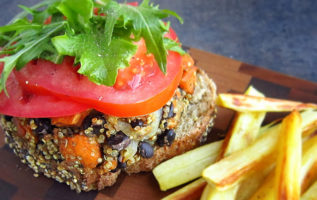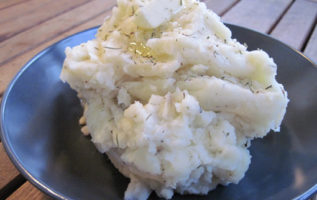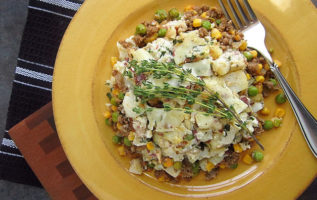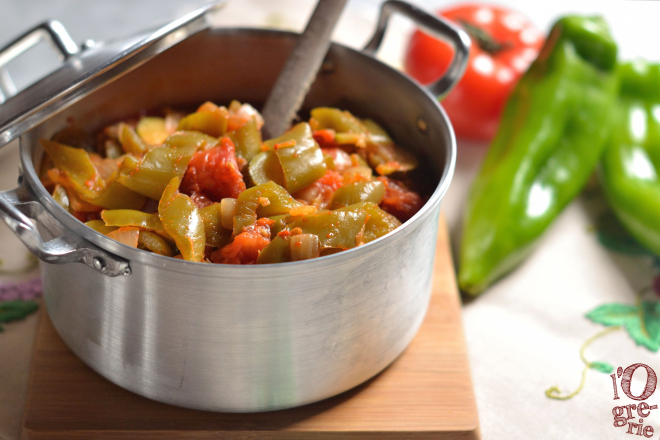
As well as the blog, this week the sunbeams have decided (again) to have a few days off, in the major part of France. But no matter : here I am again, with a recipe that brings the sun to the table and helps cheering up. Yet this is a dish I could cook all year round if only the vegetables we need to make it were equally available !
When thinking about Hungarian food, one rather pictures uninviting potato stews, smoking soups (and not the light kind I was talking about last time), deep-fried dishes and heavy desserts – and I acknowledge this actually isn’t just a cliché. Whatever your weight, Hungarian people would always find you skinny and try to feed you up till you beg for mercy, seeing no problem with serving you a substantial plate of piping hot gulyás even by 100°F /38°C.
But having Hungarian roots allows me to reveal you some of the secrets of this cuisine, and here’s one : the lands surrounding the Danube do grow vegetables too (other than potatoes), which they even use for cooking !
Thus, here’s one of these (rare) dishes of Hungarian food repertory that I have no shame to serve and eat, even on a hot summer day. It is light, vegan unless you decide to add meat or eggs, and more, it is easy as a-b-c : it basically consists in stewing peppers with tomatoes until they soften and release water, turning into a kind of soup that reminds the well-known French ratatouille.
But lecsó (pronounce letch-oh) is beyond compare, and much more than a simple vegetable soup ! Its unique flavour comes from a magic ingredient that every Hungarian cook worthy of the name shall have on hand, that is : paprika.
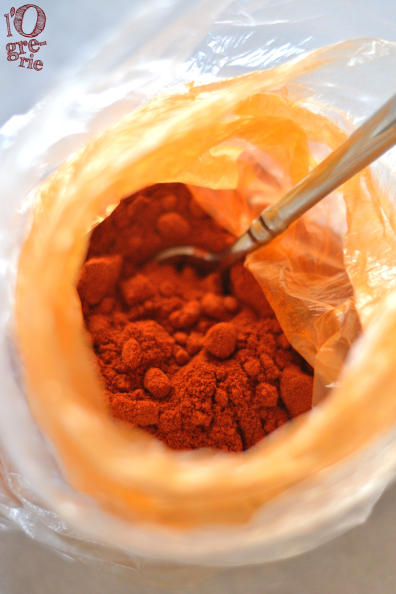
I always store a bag of it in my pantry, and feel amazed each time I use it of how this scarlet powder, though not as strongly aromatic as some other spices, is able to take the dishes to a higher level, bringing to perfection the combined foods’ natural tastes.
This very dish is usually prepared with the pale, yellowish green peppers called zöld paprika (that is green pepper, aka Hungarian wax peppers) that my Hungarian grandma may buy in plenty, especially during summer. Members of the capsicum family, they’re yet longer and have a thinner flesh that bell-pepper, which is the most widely available capsicum here in France. There are two sorts among them : mild paprika and – sometimes very hot – chili paprika, than one can tell apart only with some practice. I can tell you I had a few unpleasant surprises about them…! But the mild ones are crunchy and juicy, as fresh as cucumber, and I love eating them raw as a snack or side, simply sprinkled with some salt.
Sadly, these babies (just like their smallest, tomato-looking siblings called “apple peppers”, which I mostly know in the form of fiery pickles), are quite impossible to get, out here. Searching the Web, I found out a close variety called banana pepper that would surely do in case it is easier to find in your living area. Using regular chili peppers, though risky if you’re not much into spicy foods, would be a suitable option too. Anyway, consider picking any kind of pepper – other than bell pepper – which is convenient for you.
As for me, I changed my plans (which were to wait the opportunity to have peppers brought from Hungary by ourselves or my grandma, as usual, to tell you about this recipe) when I saw on the market the first decent tomatoes and, mostly, a range of glistening green, long and thin peppers (more customary grown in the South of France). Imitating my grandma, I bought 2 pounds, and I gladly found out that they lended themselves very well to making lecsó : it actually is the better take on the traditional recipe I tried so far. No need to say more !
Ingredients :
Yield 1.5l lecsó ~4 servings.
- 200gr yellow onion (~2 medium pcs)
- 700gr Hungarian wax peppers (see hereabove for alternatives) (~7 pcs)
- 700gr ripe tomatoes (~4 medium pcs)
- 1,5 tbsp vegetable oil
- 1 heaping tsp powdered red paprika
- 1 vegetable stock cube / ½ tsp vegetable stock powder (optional but highly recommended)
- 150gr courgette / zucchini (~1/2 medium pc) (optional but highly recommended)
- Kolbász (Hungarian paprika-flavored dry sausage, preferably smoked), may be substituted with a dry, medium hot chorizo / 1-2 eggs (optional)
- 1 tsp piros arany csemege (mild red pepper paste) or erős pista (Hungarian chili paste – possibly homemade), or substitute another kind of red pepper paste, mild or hot to your liking (optional)
- salt, pepper to taste
You might have noticed that no liquid ingredient is involved here, since the vegetables have enough moisture on their own ; however, this is the zucchini that allows the stew to be really watery, so if you’re not using it and if the stew seems to be drying out toward the end of cooking, feel free to add some water (by the tablespoon).
And regarding the peppers, don’t hesitate to let me know about your choices and how it turned out !
Note : all the abovementioned products might be found at online groceries, such as this one (eBay) or these other ones.
Method :
Peel and chop the onions.
Wash and pat dry the peppers, then halve them lengthwise.
Remove the stem, seeds and membranes and cut aslant each half into 1/2-inch/1 cm wide slices.
Rinse the tomatoes and peel them, using a vegetable peeler or this old-school technique : bring water to a boil in a pot, make a cross-shaped snip at the base of each tomato and drop them into the boiling water for 30 seconds to 1 minute, until they look slightly wilted and the skin loosens from the flesh. Take them out carefully with a slotted spoon and peel off the skin delicately.
Remove the tomatoes’ core and cut them into quarters.
Heat the oil in a frying pan over medium heat.
Add the onions and fry, stirring frequently, until translucent (do not let them brown), which takes about 5 mns.
Add the peppers and tomatoes and stir quickly to combine.
Season with salt and pepper, then sprinkle with the paprika and the stock cube (crumbled) or powder.
Mix well, cover and simmer over low heat for 15 mns (more or less).
In the meantime, wash well and pat dry the zucchini, leaving the skin on.
Halve it lengthwise and slice it very thinly (into ~ 1-2 mm thick slices).
When the peppers are softened and tomatoes have released their juices, add the zucchini slices to the pan.
Stir to distribute them evenly, cover again and keep cooking over low heat until they’re cooked through, which takes about 25 mns.
Toward the end of cooking, add one or more of the following optional ingredients, to your liking :
- paprika paste to enhance the powdered form’s flavour,
- thin slices of sausage (~10 per serving) for a richer-tasting dish,
- or the egg(s), beaten beforehand, for a still vegetarian but more subsistent one.
Cook for 3 to 5 mns more to have the sausage or eggs cooked through and the flavours melted.
Divide into shallow plates and enjoy !
The lecsó might be served as is, as a starter or main course, with some bread to sop up the last of the stew (and because it would perhaps be too light then), or as a side dish, with spätzle for instance.
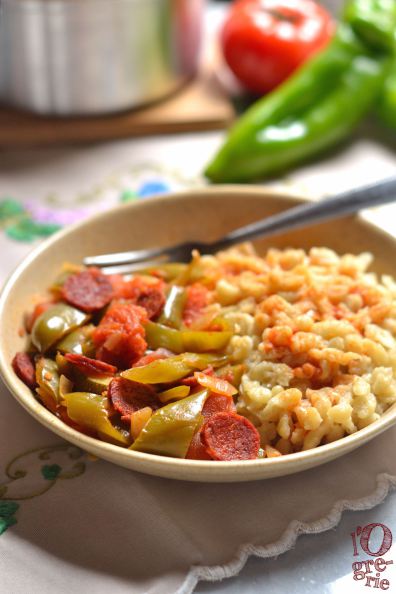
Like most of the stews, it is fine to reheat it, at best in a pot or pan, over medium heat (though I admit I sometimes just pop it in the microwawe, where it is ready in a couple of minutes…).
But anyway, make sure not to keep it too long in the fridge (say, no more than 3 days), since the low fat content causes the veggies to go bad faster.
However, it is quite convenient to make it in bulk, put the leftover into one or more airtight containers, and straight to the freezer (believe me, once you’ll have given a try to lecsó, you’d always want to have some on hand ;)) ! If doing so, I’d recommend you to thaw it thoroughly before reheating.
Jó étvágyat !
Source: logrerie.wordpress.com (defunct blog)




















